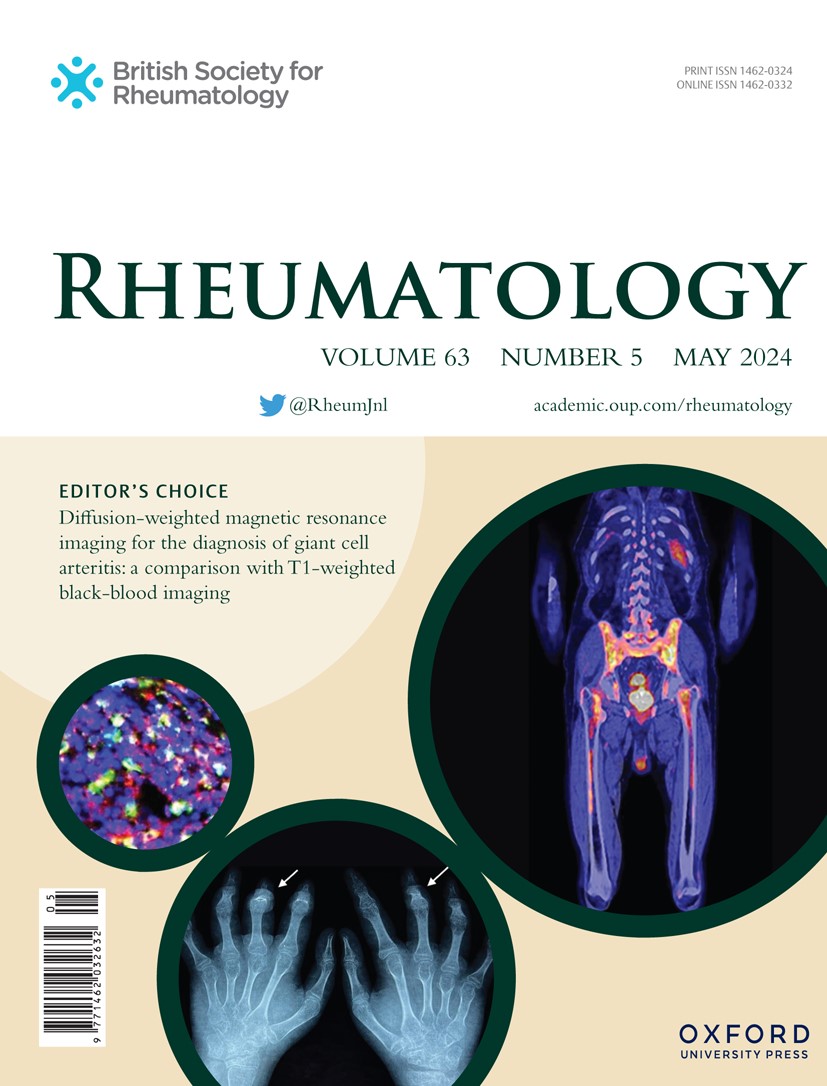预测难治性类风湿关节炎的快速影像学进展:来自长期随访的见解。
IF 4.4
2区 医学
Q1 RHEUMATOLOGY
引用次数: 0
摘要
目的探讨难治性类风湿关节炎(D2T RA)和多难治性RA (pr-RA)患者影像学进展的长期发展趋势,并评估基于超声的持续性炎性难治性RA (PIRRA)和非炎性难治性RA (NIRRA)分级对预测快速影像学进展(RRP,≥5 mSvdH单位/年)的影响。方法采用改进的Sharp/van der Heijde (mSvdH)评分对eular定义的D2T RA患者进行影像学损伤评估。PIRRA和NIRRA亚组根据单一超声时间点评估灰度和功率多普勒滑膜炎进行分类。研究了时间积分CRP和关节肿胀计数(SJC)对x线片进展的影响。结果254例D2T类RA患者中,114例有连续x线片,平均随访9年。平均每年mSvdH进展为2.8个单位,时间积分CRP (p< 0.001)和PIRRA患者(n = 43)的年放射学进展明显更大(PIRRA为3.3个单位,NIRRA为2.4个单位,p= 0.025)。在多变量分析中,年龄(p= 0.017)和关节肿胀计数(p= 0.009)与RRP独立相关。此外,50%的pr-RA患者(n = 14)观察到RRP,而其他D2T -RA患者为19.4% (p= 0.048)。结论:虽然这是一个罕见的亚组,但有一半的前ra病例表现出RRP,强调需要更积极的治疗方法。相反,许多D2T类风湿性关节炎患者表现出相对缓慢的影像学进展,这表明许多D2T类风湿性关节炎患者至少得到了部分治疗。这些发现强调了D2T RA的异质性,并强调了对pr-RA亚组采取额外策略的必要性。本文章由计算机程序翻译,如有差异,请以英文原文为准。
Predicting rapid radiographic progression in difficult-to-treat rheumatoid arthritis: insights from long-term follow-up.
OBJECTIVES
To investigate the long-term trajectory of radiographic progression in difficult-to-treat rheumatoid arthritis (D2T RA) and poly-refractory RA (pr-RA) patients and to evaluate the impact of ultrasound-based persistent inflammatory refractory RA (PIRRA) and non-inflammatory refractory RA (NIRRA) classification on predicting rapid radiographic progression (RRP, ≥5 mSvdH units/year).
METHODS
Radiographic damage was assessed using the modified Sharp/van der Heijde (mSvdH) score in EULAR-defined D2T RA patients. PIRRA and NIRRA subgroups were classified based on a single ultrasound timepoint assessing grayscale and power Doppler synovitis. The impact of time-integrated CRP and swollen joint counts (SJC) on radiographic progression was examined.
RESULTS
Among 254 D2T RA patients, 114 had serial radiographs with a mean follow-up of 9 years. The mean annual mSvdH progression was 2.8 units with both time-integrated CRP (p< 0.001) and the PIRRA patients (n = 43) having significantly greater annual radiographic progression (3.3 in PIRRA vs 2.4 units in NIRRA, p= 0.025). In multivariable analysis, older age (p= 0.017) and swollen joint count (p= 0.009) were independently associated with RRP. Additionally, RRP was observed in 50% of pr-RA patients (n = 14) vs 19.4% in other D2T RA cases (p= 0.048).
CONCLUSION
Although an uncommon subgroup, half of pr-RA cases demonstrated RRP, emphasizing the need for more aggressive treatment approaches. In contrast, many D2T RA patients exhibited comparatively slow radiographic progression indicating that many D2T RA cases are at least partially treated. These findings underscore the heterogeneity within D2T RA and highlight the need for additional strategies for the pr-RA subgroup.
求助全文
通过发布文献求助,成功后即可免费获取论文全文。
去求助
来源期刊

Rheumatology
医学-风湿病学
CiteScore
9.40
自引率
7.30%
发文量
1091
审稿时长
2 months
期刊介绍:
Rheumatology strives to support research and discovery by publishing the highest quality original scientific papers with a focus on basic, clinical and translational research. The journal’s subject areas cover a wide range of paediatric and adult rheumatological conditions from an international perspective. It is an official journal of the British Society for Rheumatology, published by Oxford University Press.
Rheumatology publishes original articles, reviews, editorials, guidelines, concise reports, meta-analyses, original case reports, clinical vignettes, letters and matters arising from published material. The journal takes pride in serving the global rheumatology community, with a focus on high societal impact in the form of podcasts, videos and extended social media presence, and utilizing metrics such as Altmetric. Keep up to date by following the journal on Twitter @RheumJnl.
 求助内容:
求助内容: 应助结果提醒方式:
应助结果提醒方式:


